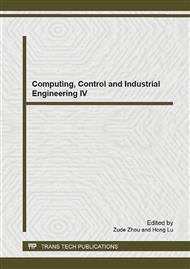[1]
Li T. and Xie L., Distributed Coordination of Multi-agent systems with quantized-observer based encoding-decoding, IEEE Trans. Autom. Control, 2012, 57(12), 3023-3037.
DOI: 10.1109/tac.2012.2199152
Google Scholar
[2]
Liu Z., Guan Z. and Shen X. et al., Consensus of Multi-agent networks with aperiodic sampled communication via impulsive algorithms using position-only measurements, IEEE Trans. Autom. Control, 2012, 57(10), 2639-2643.
DOI: 10.1109/tac.2012.2214451
Google Scholar
[3]
Hendrickx, Julien M. and Tsitsiklis et al., Convergence of type-symmetric and cut-balanced consensus seeking systems, IEEE Trans. Autom. Control, 2013, 58(1), 214-218.
DOI: 10.1109/tac.2012.2203214
Google Scholar
[4]
Hong Y., Gao L., Cheng D. and Hu J., Lyapunov based approach to multi-agent systems with switching jointly-connected interconnection, IEEE Trans. Autom. Control, 2007, 52, 943-948.
DOI: 10.1109/tac.2007.895860
Google Scholar
[5]
Hong Y., Chen G. and Bushnell L., Distributed observers design for leader-following control of mulit-agent networks, Automatica, 2008, 44, 846- 850.
DOI: 10.1016/j.automatica.2007.07.004
Google Scholar
[6]
Ren W. and Beard R., Consensus seeking in multi-agent systems using dynamically changing interaction topologies, IEEE Trans. Autom. Control, 2005, 50, 665-671.
DOI: 10.1109/tac.2005.846556
Google Scholar
[7]
Couzin I.D., Krause J., Franks N. and Levin S., Effective leadership and decision making in animal groups on the move, Nature, 2005, 433, 513-516.
DOI: 10.1038/nature03236
Google Scholar
[8]
Fax A. and Murray R.M., Information flow and cooperative control of vehicle formations, IEEE Trans. Autom. Control, 2004, 49, 1465-1476.
DOI: 10.1109/tac.2004.834433
Google Scholar
[9]
Hong Y., Hu J. and Gao L., Tracking control for multi-agent consensus with an active leader and variable topology, Automatica, 2006, 42, 1177-1182.
DOI: 10.1016/j.automatica.2006.02.013
Google Scholar
[10]
Lin P., Jia Y. and Li L., Distributed robust consensus control in directed networks of agents with time-delay, System & Control Letters, 2008, 57, 643-653.
DOI: 10.1016/j.sysconle.2008.01.002
Google Scholar
[11]
Li X. and Zhou K., A time domain approach to robust fault detection of linear time-varying systems, Automatica, 2009, 45, 94-102.
DOI: 10.1016/j.automatica.2008.07.017
Google Scholar
[12]
Ren W., Consensus tracking under directed interaction topologies: algorithms and experiments, IEEE Trans. Control Systems Technology, 2010, 18, 230-237.
DOI: 10.1109/tcst.2009.2015285
Google Scholar
[13]
Godsil C. and Royle G., Algebraic graph theory, Springer, New York., (2001).
Google Scholar


